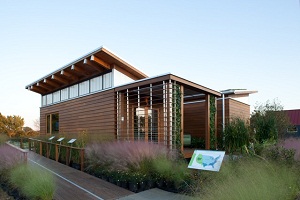University of Maryland takes top honors at Solar Decathlon
 The 2011 U.S. Solar Decathlon hosted by the Department of Energy from Sept. 22 to Oct. 2 was a success, seeing more visitors to homes than ever before, despite being moved from the heart of the National Mall between the Smithsonian museums to its less traveled West Potomac Park.
The 2011 U.S. Solar Decathlon hosted by the Department of Energy from Sept. 22 to Oct. 2 was a success, seeing more visitors to homes than ever before, despite being moved from the heart of the National Mall between the Smithsonian museums to its less traveled West Potomac Park.
The event’s newest challenge, the affordability challenge, was likely one of the most important factors influencing the design and building of homes, but it didn’t stop the University of Maryland or other schools from creating innovative, solar-powered, energy-efficient homes that wowed visitors and judges alike.
The University of Maryland’s WaterShed house won this year’s U.S. Solar Decathlon, hosted by the Department of Energy, with 951 points, besting Perdue University’s INhome, which scored 931 points in the 1,000 point contest.
But perhaps the biggest surprise was New Zealand’s First Light Bach house, which rose in the final three days of contests to place third overall with 919 points. In 2009, Team Germany, the winner of that contest, only received 908 points and was the only team to break 900 points.
In 2011, the top five teams, rounded out by Middlebury College and Ohio State University, all scored over 900 points in the contests.
During much of the event, which is open to the public, it was cloudy and muggy. Still, the event saw more house visits than in 2009’s event.
“We were quite pleased, especially with the weather and site being further away,” said DOE’s Solar Decathlon Director Richard King.
There were 357,000 house visits this year as opposed to 307,000 in 2009. The through traffic may have been less because of its less accessible position on the Mall and the weather, he said.
“People are so interested in what the students are doing,” King said.
The innovations the student teams developed for the homes were interesting to homeowners and other visitors, he said.
The affordability challenge also introduced an important new dynamic to the challenge that may have made the homes more interesting to the public—particularly during the recovery from the economic meltdown that began in 2008.
“It was a tougher challenge to build a very energy-efficient high-energy house,” King said.
Students designed homes using many off-the-shelf products that have come down in price in recent years, as not just the price of photovoltaics have fallen, but also as Energy Star appliances and other energy-efficiency products have become more mainstream, according to King.
“The price of things is coming down. Two years ago, triple-pane windows were really expensive, and now I saw [such] windows from several companies in the homes,” he said.
And despite the overcast skies, many of the homes produced a surplus of electricity during the competition, and others came close to being net-zero, he said.
“We had so many clouds,” King said. “It really showed how energy-efficient these homes were.”
Image courtesy of the Solar Decathlon.



